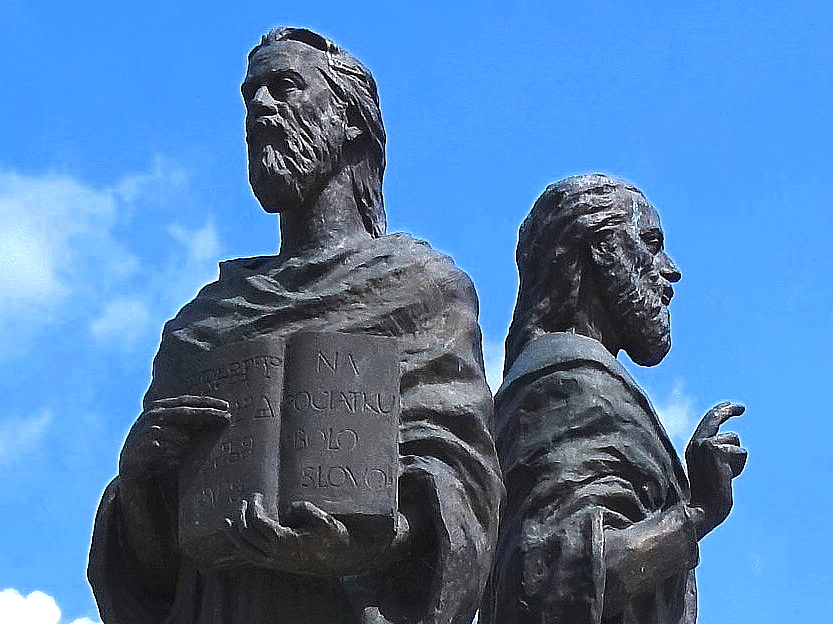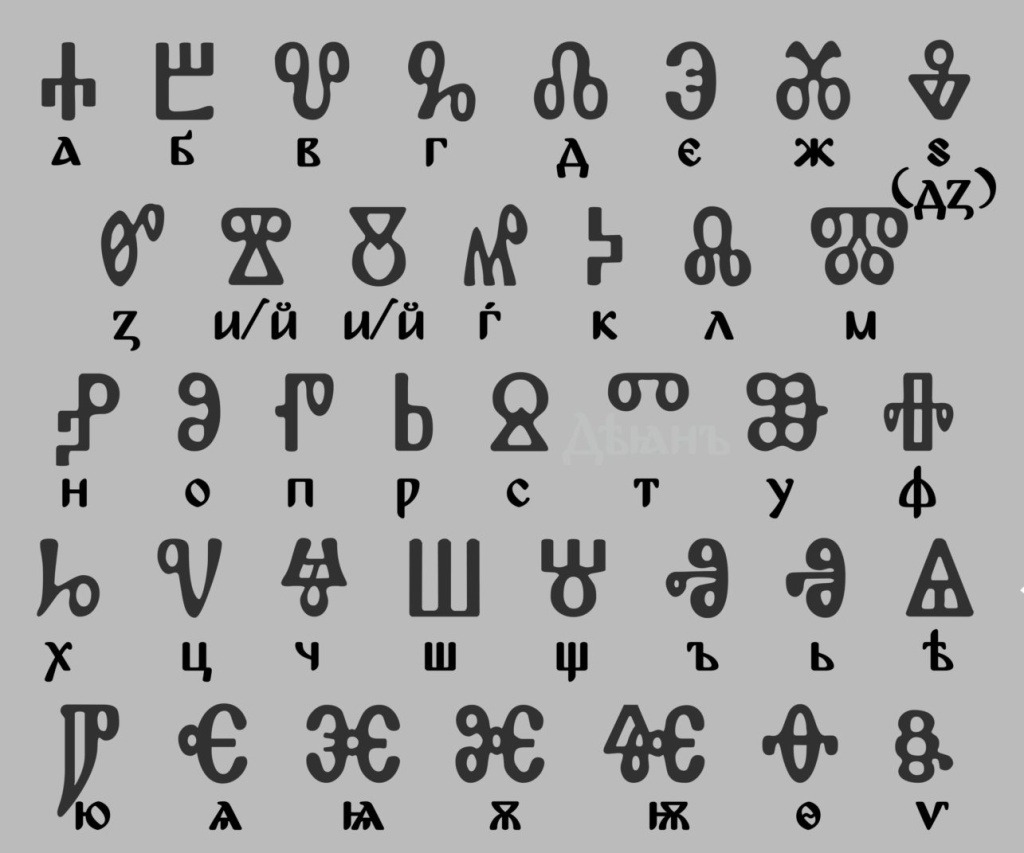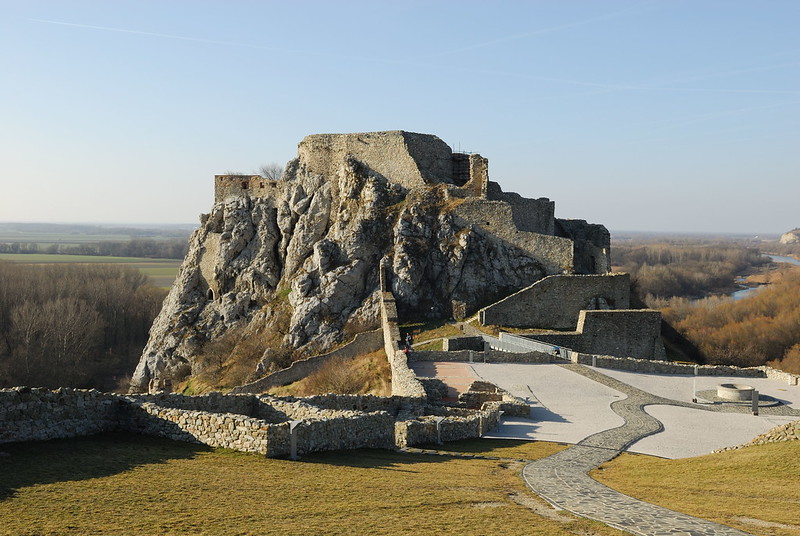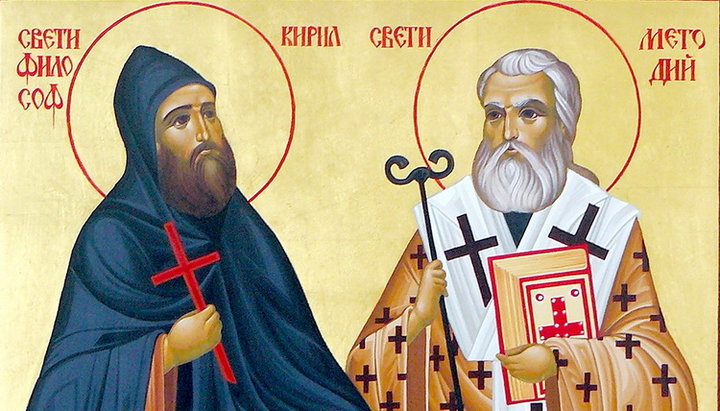
Cyril and Methodius: Great Mission of the Enlighteners
/ Главная / Russkiy Mir Foundation / Publications / Cyril and Methodius: Great Mission of the EnlightenersCyril and Methodius: Great Mission of the Enlighteners
Central European countries hold large-scale events dedicated to St. Cyril and Methodius, Christian preachers, and the creators of the Slavic alphabet and the Church Slavonic language.

Monument to Cyril and Methodius in Sečovce, eastern Slovakia
The commemoration of the arrival of St. Cyril and Methodius in Moravia is not only about church life. Its aim is to share the cultural and educational impact of the activities performed by the brothers from Thessalonica.
Cyril and Methodius were canonized. They are honored in both the East and West of Christendom.
From soldier to monk
The brothers were born in the city of Solun (now known as Thessaloniki). Methodius was born in 815, and the younger brother was born twelve years later. His birth name was Constantine, and he became Cyril only after his tonsure as a monk, shortly before he died.
The brothers descended from a good family. Their father was an officer in the Byzantine army. Byzantium, including Solun, was a multinational empire. Thus, it is impossible to identify the ethnicity of Cyril and Methodius. Yet, some indirect evidence suggests their Greek ancestry. However, many historians in various Slavic countries attempted to prove that the brothers had been of Solun Slavic origin.
Both brothers had an excellent education. Yet, they walked different paths of life for a long time. Methodius succeeded in military service but then converted to a monk and became abbot of a monastery on Bithynian Olympus Mount (now Uludağ in Turkey). Cyril was fascinated by the studies of ecclesiastical works from an early age and eventually became involved in teaching and missionary activities.
At the end of the 850s, the brothers had a circle of like-minded people formed at the monastery headed by Methodius. In 860, the brothers participated in the famous Khazar Mission. Cyril sought to convince the Khazar Khagan to adopt Christianity through a dispute with a rabbi and a Jew. The Khagan refused to convert, so Cyril and Methodius returned to Byzantium and almost immediately left for Moravia.
Glagolitic alphabet
The brothers developed the first Slavonic script for the mission. It was the Glagolitic alphabet (Hlaholika in Slovak). It was mostly devised by Cyril. He used graphemes from the old Greek script and Eastern alphabets as the basis. Glagolitic had more letters to reflect the language phonetics more precisely. It was the wish to devise such an alphabet that inspired the enlightener to start working on a new script.
The initial Moravian version of the Glagolitic alphabet consisted of 38 graphemes. Glagolitic characters also represented numbers, so it was possible to make both words and numerals out of them.

Glagolitic alphabet
The Glagolitic alphabet did not become widespread and was almost completely superseded by the Cyrillic alphabet. The only Slavic nation that continued to use the Glagolitic script until the 19th century was the Croats.
Yet, Cyril's work was of great importance to the Slavic culture. In fact, the first Slavic literary language was created during the development of the Glagolitic alphabet. This language is now known as Old Slavic (Staroslovienčina in Slovak). It was based on the old Macedonian language spoken by the Slavs living in Solun back then. Cyril and Methodius used the new alphabet to make the first translations of Greek religious texts into Slavic.
Great Moravian Academy
Educational activities were the main part of Cyril and Methodius' mission. They were conducted in the Great Moravian Academy (Veľkomoravské učilište) that had been founded by Prince Rastislav in 863. The brothers taught priests-to-be and administrative workers. The academy worked for more than 20 years, and more than 200 people graduated from it.
For a long time, the academy's location remained unknown. In the late 1980s, Devín Castle was proven to be the place. Its traces had been discovered by Inokent Červinka, a Czech archaeologist, 60 years earlier.

Devín Castle. Photo credit: Flickr.com
The brothers' mission continued for a little more than three years. During that time, they translated church books from Greek into Slavic and taught the Moravians how to read, write and worship in the Slavic language.
In 867, Cyril and Methodius were invited to Rome where they met with the new Pope Adrian II. He favored the missionaries and permitted the use of the Slavic language for worship. The latter became known as the Glagolitic Rite.
One popular version suggests that the "double cross" (dvojkríž) first appeared in Moravia through Cyril and Methodius. It is an old Byzantine symbol of Jesus Christ's resurrection that subsequently became one of Slovakia's national symbols.

Flag of Slovakia
It was used as a religious and political symbol in Byzantium. Two cross bars symbolized the plate nailed over Christ's head before his execution and the bar that Jesus' feet had been nailed to. The double cross can be found on the coat of arms of Hungary, as well as on the old coat of arms of the Grand Duchy of Lithuania, which subsequently was transferred to the Belarusian and Lithuanian armory.
Cyril's Death
A trip to Rome was Cyril's last journey. In February 869, he became severely ill and passed away. His tomb is in the Basilica of Saint Clement nearby the Colosseum. As legend has it, before Cyril died, he told his brother to continue his enlightenment activities.
Following his brother's death, Methodius was ordained archbishop of Moravia and Pannonia. Methodius called back his disciples and returned to Great Moravia in 870. The country's situation had changed dramatically by that time. Prince Rastislav was defeated in a battle with the Franks and died in a Bavarian prison. His successor, Prince Sviatopolk, fully submitted to German political influence.
Having reclaimed their control of the Moravian lands, the Franks banned worship in the Slavic language and reintroduced Latin to the churches. Methodius opposed the above prohibition and was imprisoned in the Reichenau Abbey near Lake Constance in the very south of contemporary Germany.
Struggle for the Slavic Language
New Pope John VIII stood up for Methodius. He forbade the Frankish priests to conduct liturgies until his release. Nevertheless, the church head issued another directive forbidding worship in the Slavic language and permitting only sermons in it.
Methodius was released almost immediately and resumed his services in the church. He ignored John's prohibition and continued to worship in the Slavic language. As a result, in 878, the German bishops initiated a new trial against him. They accused Methodius of using Slavic language and misinterpreting the Gospel.
The conflict had to be settled in Rome again. Methodius appeared before John VIII. He managed to prove that the Frankish priests had been wrong and got a special decree from the church head where the Great Moravia was granted the same rights as the Kingdom of the East Franks. This was a great victory for Methodius who regained the right to conduct most of the services in the Slavic language.
Methodius returned to Great Moravia in 882. He spent the last three years of his life there. At that time, he and his disciples continued to translate Greek church books. On April 6, 885, 70-year-old Methodius passed away in Velehrad.
Hardly anything is known about Velehrad, the capital of Great Moravia. It was first mentioned in the Czech chronicles in the 13th century. Even its location is still unknown. According to his hagiography, it was in this town that Methodius passed away and was buried. Information about this is also scarce. The Legend of Saint Methodius says only that he "was buried in the temple of Moravian capital on the left side in the wall behind the altar of Virgin Mary". There is a small town of the same name in southern Moravia. It is the site of an annual national pilgrimage on July 5. However, this town has probably nothing to do with the "old" Velehrad.

Fresco featuring Saints Cyril and Methodius
Before he died, Methodius appointed one of his disciples, bishop Horazd from Nitra, as his successor. He was also to head the Great Moravian Academy. However, the Franks, with the consent of Prince Sviatopolk, avenged Methodius' disciples almost immediately after his death. Some of them were imprisoned, and some were exiled from the country. Horazd`s fate is unknown. Some sources claim that he was murdered, and others that he escaped persecution in modern-day Czechia, Poland, or Bulgaria.
New publications

 Mikhail Kalatozov, a director who transformed the world of cinematography in many ways, was born 120 years ago. He was a Soviet film official and a propagandist. Above all, he was capable of producing movies that struck viewers with their power and poetic language.
Mikhail Kalatozov, a director who transformed the world of cinematography in many ways, was born 120 years ago. He was a Soviet film official and a propagandist. Above all, he was capable of producing movies that struck viewers with their power and poetic language.  Ukrainian authorities have launched a persecution campaign against the canonical Ukrainian Orthodox Church (UOC), the biggest one in the country's modern history. Over the past year, state sanctions were imposed on clergy representatives, searches were conducted in churches, clergymen were arrested, criminal cases were initiated, the activity of the UOC was banned in various regions of the country, and monasteries and churches were seized.
Ukrainian authorities have launched a persecution campaign against the canonical Ukrainian Orthodox Church (UOC), the biggest one in the country's modern history. Over the past year, state sanctions were imposed on clergy representatives, searches were conducted in churches, clergymen were arrested, criminal cases were initiated, the activity of the UOC was banned in various regions of the country, and monasteries and churches were seized.  When Nektary Kotlyaroff, a fourth-generation Russian Australian and founder of the Russian Orthodox Choir in Sydney, first visited Russia, the first person he spoke to was a cab driver at the airport. Having heard that Nektariy's ancestors left Russia more than 100 years ago, the driver was astonished, "How come you haven't forgotten the Russian language?" Nektary Kotlyaroff repeated his answer in an interview with the Russkiy Mir. His affinity to the Orthodox Church (many of his ancestors and relatives were priests) and the traditions of a large Russian family brought from Russia helped him to preserve the Russian language.
When Nektary Kotlyaroff, a fourth-generation Russian Australian and founder of the Russian Orthodox Choir in Sydney, first visited Russia, the first person he spoke to was a cab driver at the airport. Having heard that Nektariy's ancestors left Russia more than 100 years ago, the driver was astonished, "How come you haven't forgotten the Russian language?" Nektary Kotlyaroff repeated his answer in an interview with the Russkiy Mir. His affinity to the Orthodox Church (many of his ancestors and relatives were priests) and the traditions of a large Russian family brought from Russia helped him to preserve the Russian language.

 The leaders of the Friends of the Great Russia cultural association (Amici Della Grande Russia) in Italy believe that the Western policy of abolishing Russian culture in Europe has finally failed. Furthermore, it was doomed to failure from the beginning.
The leaders of the Friends of the Great Russia cultural association (Amici Della Grande Russia) in Italy believe that the Western policy of abolishing Russian culture in Europe has finally failed. Furthermore, it was doomed to failure from the beginning.  Name of Vladimir Nemirovich-Danchenko is inscribed in the history of Russian theater along with Konstantin Stanislavski, the other founding father of the Moscow Art Theater. Nevertheless, Mr. Nemirovich-Danchenko was a renowned writer, playwright, and theater teacher even before their famous meeting in the Slavic Bazaar restaurant. Furthermore, it was Mr. Nemirovich-Danchenko who came up with the idea of establishing a new "people's" theater believing that the theater could become a "department of public education."
Name of Vladimir Nemirovich-Danchenko is inscribed in the history of Russian theater along with Konstantin Stanislavski, the other founding father of the Moscow Art Theater. Nevertheless, Mr. Nemirovich-Danchenko was a renowned writer, playwright, and theater teacher even before their famous meeting in the Slavic Bazaar restaurant. Furthermore, it was Mr. Nemirovich-Danchenko who came up with the idea of establishing a new "people's" theater believing that the theater could become a "department of public education."  "Russia is a thing of which the intellect cannot conceive..." by Fyodor Tyutchev are famous among Russians at least. December marks the 220th anniversary of the poet's birth. Yet, he never considered poetry to be his life's mission and was preoccupied with matters of a global scale. Mr.Tyutchev fought his war focusing on relations between Russia and the West, the origins of mutual misunderstanding, and the origins of Russophobia. When you read his works today, it feels as though he saw things coming in a crystal ball...
"Russia is a thing of which the intellect cannot conceive..." by Fyodor Tyutchev are famous among Russians at least. December marks the 220th anniversary of the poet's birth. Yet, he never considered poetry to be his life's mission and was preoccupied with matters of a global scale. Mr.Tyutchev fought his war focusing on relations between Russia and the West, the origins of mutual misunderstanding, and the origins of Russophobia. When you read his works today, it feels as though he saw things coming in a crystal ball...